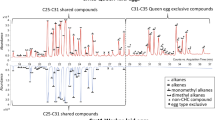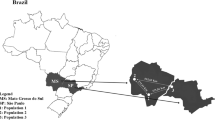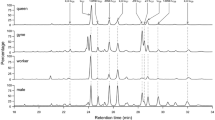Abstract
In social insects, cuticular hydrocarbons (CHCs) play a central role in nestmate recognition. CHCs have proved to be useful for identifying species and differentiating populations. In combination with CHCs, isoprenoid soldier defensive secretions (SDSs) have been previously used in some termite species for chemotaxonomic analyses. This study compared the levels of chemical variation within and among introduced (French) and native (U.S.) populations of the subterranean termite, Reticulitermes flavipes. Worker CHCs and soldier SDSs from termites collected from colonies in nine populations in Florida, Louisiana, and France were analyzed. Discriminant analyses revealed that both localities and populations can be distinguished by using the variation in CHC profiles. Principal component analyses of CHC profiles as well as the calculation of two distance parameters (Nei and Euclidean) revealed remarkable chemical homogeneity within and among French populations. These analyses also showed that the CHC profiles of French populations were closer to termite populations from Louisiana than to those from Florida. Of the six distinct SDS chemotypes, one was common to populations in France and Louisiana. The possibility that populations in France originated from Louisiana, and the potential causes and consequences of chemical homogeneity within introduced populations are discussed.




Similar content being viewed by others
References
Austin, J. W., Szalanski, A. L., Uva, P., Bagnères, A. -G., and Kence, A. 2002. A comparative genetic analysis of the subterranean termite genus Reticulitermes (Isoptera: Rhinotermitidae). Ann. Entomol. Soc. Am. 95:753–760.
Austin, J. W., Szalanski, A. L., Scheffrahn, R. H., Messenger, M. T., Dronnet, S., and Bagnères, A. -G. 2005. Genetic evidence for the synonymy of two Reticulitermes species: Reticulitermes flavipes and Reticulitermes santonensis. Ann. Entomol. Soc. Am. 98:395–401.
Austin, J. W., Bagnères, A. -G., Szalanski, A. L., Scheffrahn, R. H., Heintschel, B. P., Messenger, M. T., Clément, J. -L., and Gold, R. E. 2007. Reticulitermes malletei (Isoptera : Rhinotermitidae): a valid nearctic subterranean termite from eastern North America. Zootaxa (1554):1–26.
Bagnères, A. -G. 2006. Recent data on termite invasion and infestation in Western Europe, p. 80, in Proceedings of National Conference on Urban Entomology, May 14–21, 2006, Raleigh, NC, USA.
Bagnères, A. -G. and Wicker-thomas, C. 2010. Chemical taxonomy with hydrocarbons, pp. 121–162, in G. J. Blomquist and A.-G. Bagnères (eds.). Insect Hydrocarbons: Biology, Biochemistry and Chemical Ecology. Cambridge University Press, Cambridge, UK.
Bagnères, A. -G., Clément, J. -C., Blum, M. S., Severson, R. F., Joulie, C. and Lange, C. 1990. Cuticular hydrocarbons and defensive compounds of Reticulitermes flavipes (Kollar) and R. santonensis (Feytaud): polymorphism and chemotaxonomy. J. Chem. Ecol. 16:3213–3244.
Blomquist, G. J. and Bagnères, A.-G. 2010. Insect Hydrocarbons: Biology, Biochemistry, and Chemical Ecology. Cambridge University Press, Cambridge, UK, p. 528.
Bobe-moreau, J. 1843. Mémoire sur les Termites observés à Rochefort et dans divers autres lieux du département de la Charente-Inférieure. Saintes.
Brandt, M., Van Wilgenburg, E., and Tsutsui, N. D. 2009. Global-scale analyses of chemical ecology and population genetics in the invasive Argentine ant. Mol. Ecol. 18:997–1005.
Brown, W. V., Watson, J. A. L., Carter, F. L., Lacey, M. J., Barett, R. A., and Mcdaniel, C. A. 1990. Preliminary examination of cuticular hydrocarbons of worker termites as chemotaxonomic characters for some Australian species of Coptotermes (Isoptera: Rhinotermitidae). Sociobiol. 16:305–328.
Carlin, N. F. and Hölldobler, B. 1986. The kin recognition system of carpenter ants (Camponotus spp.) I. Hierarchical cues in small colonies. Behav. Ecol. Sociobiol. 19:123–134.
Clément, J. -L. and Bagnères, A. -G. 1998. Nestmate recognition in termites, pp. 126–155, in R. K. Vander Meer, M. D. Breed, K. E. Espelie, and M. L. Winston (eds.). Pheromone Communication in Social Insects. Ants, Wasps, Bees, and Termites: Westview Press, Boulder, CO, US.
Clément, J. -L., Bagnères, A. -G., Uva, P., Wilfert, L., Quintana, A., Reinhard, J., and Dronnet, S. 2001. Biosystematics of Reticulitermes termites in Europe: morphological, chemical and molecular data. Insectes Soc. 48:202–215.
Copren, K. A., Nelson, L. J., Vargo, E. L., and Haverty, M. I. 2005. Phylogenetic analyses of mtDNA sequences corroborate taxonomic designations based on cuticular hydrocarbons in subterranean termites. Mol. Phylogenet. Evol. 35:689–700.
Dronnet, S., Chapuisat, M., Vargo, E. L., Lohou, C., and Bagnères, A. -G. 2005. Genetic analysis of the breeding system of an invasive subterranean termite, Reticulitermes santonensis, in urban and natural habitats. Mol. Ecol. 14:1311–1320.
Dronnet, S., Lohou, C., Christidès, J. -P., and Bagnères, A. -G. 2006. Cuticular hydrocarbon composition reflects genetic relationship among colonies of the introduced termite Reticulitermes santonensis Feytaud. J. Chem. Ecol. 32:1027–1042.
Elliott, K. L. and Stay, B. 2007. Juvenile hormone synthesis as related to egg development in neotenic reproductives of the termite Reticulitermes flavipes, with observations on urates in the fat body. Gen. Comp. Endocrinol. 152:102–110.
Errard, C., Delabie, J., Jourdan, H., and Hefetz, A. 2005. Intercontinental chemical variation in the invasive ant Wasmannia auropunctata (Roger) (Hymenoptera Formicidae): a key to the invasive success of a tramp species. Naturwissenschaften 92:319–323.
Feytaud, D. J. 1924. Le termite de Saintonge. Compte-Rendus de l’Académie des Sciences 171:203–205.
Florane, C. B., Bland, J. M., Husseneder, C., and Raina, A. K. 2004. Diet-mediated inter-colonial aggression in the Formosan subterranean termite Coptotermes formosanus. J. Chem. Ecol. 30:2559–2574.
Giraud, T., Pedersen, J. S., and Keller, L. 2002. Evolution of supercolonies: The Argentine ants of southern Europe. Proc. Natl. Acad. Sci. USA. 99:6075–6079.
Hanus, R., Vrkoslav, V., Hrdy, I., Cvacka, J., and Sobotnik, J. 2010. Beyond cuticular hydrocarbons: evidence of proteinaceous secretion specific to termite kings and queens. Proc. Royal Soc. B Biol. Sci. 277: 995–1002.
Haverty, M. I., Nelson, L. J., and Page, M. 1990. Cuticular hydrocarbons of fourpopulations of Coptotermes formosanus Shiraki (Isoptera, Rhinotermitidae) in the United States—Similarities and origins of introductions. J. Chem. Ecol. 16:1635–1647.
Haverty, M. I., Nelson, L. J., and Page, M. 1991. Preliminary investigations of the cuticular hydrocarbons from North American Reticulitermes and Tropical and Subtropical Coptotermes (Isoptera: Rhinotermitidae) for chemotaxonomic studies. Sociobiology 19:51–76.
Haverty, M. I., Grace, J. K., Nelson, L. J., and Yamamoto, R. T. 1996. Intercaste, intercolony, and temporal variation in cuticular hydrocarbons of Coptotermes formosanus Shiraki (Isoptera: Rhinotermitidae). J. Chem. Ecol. 22:1813–1834.
Haverty, M. I., Collins, M. S., Nelson, L. J., and Thorne, B. L. 1997. Cuticular hydrocarbons of termites of the British Virgin Islands. J. Chem. Ecol. 23:927–964.
Haverty, M. I., Woodrow, R. J., Nelson, L. J., and Grace, J. K. 2000. Cuticular hydrocarbons of termites of the Hawaiian Islands. J. Chem. Ecol. 26:1167–1191.
Henderson, G. 1998. Primer pheromones and possible soldier caste influence on the evolution of sociality in lower termites, pp. 314–330, in R. K. Vander Meer, M. D. Breed, M. L. Winston, and K. E. Espelie (eds.). Pheromone Communication in Social Insects: Ants, Wasps, Bees and Termites. Westview Press, Boulder, CO, US.
Howard, R. W. 1993. Cuticular hydrocarbons and chemical communication, pp. 179–226, in D. W. Stanley-Samuelson and D. R. Nelson (eds.). Insect Lipids: Chemistry, Biochemistry and Biology. University of Nebraska Press, Lincoln, NE, US.
Howard, R. W. and Blomquist, G. J. 2005. Ecological, behavioral, and biochemical aspects of insect hydrocarbons. Annu. Rev. Entomol. 50:371–393.
Howard, K. J., Mcdaniel, C. A., and Blomquist, G. J. 1978. Cuticular hydrocarbons of the eastern subterranean termite, Reticulitermes flavipes (Kollar) (Isoptera: Rhinotermitidae). J. Chem. Ecol. 4:233–245.
Howard, R. W., Mcdaniels, C. A., Nelson, D. R., Blomquist, G. J., Gelbaum, L. T., and Zalkow, L. H. 1982. Cuticular hydrocarbons of Reticulitermes virginicus (Banks) and their role as potential species and caste recognition cues. J. Chem. Ecol. 8:1227–1239.
Jenkins, T. M., Haverty, M. I., Basten, C. J., Nelson, L. J., Page, M., and Forschler, B. T. 2000. Correlation of mitochondrial haplotypes with cuticular hydrocarbon phenotypes of sympatric Reticulitermes species from the southeastern United States. J. Chem. Ecol. 26:1525–1542.
Jenkins, T. M., Dean, R. E., Verkerk, R., and Forschler, B. 2001. Phylogenetic analyses of two mitochondrial genes and one nuclear intron region illuminate European subterranean termite (Isoptera: Rhinotermitidae) gene flow, taxonomy, and introduction dynamics. Mol. Phylogenet. Evol. 20:286–293.
Kaib, M., Brandl, R., and Bagine, R. K. N. 1991. Cuticular hydrocarbon profiles: a valuable tool in termite taxonomy. Naturwissenschaften 78:176–179.
Leniaud, L. 2008. Potentialités ontogéniques, différenciation des castes et conséquences sur la structure génétique des termites du genre Reticulitermes. Ph.D. Dissertation. Université François Rabelais, Tours, p 193.
Nei, M. 1987. Molecular evolutionary genetics. Columbia University Press, New York.
Nelson, L. J., Cool, L. G., Forschler, B. T., and Haverty, M. I. 2001. Correspondence of soldier defense secretion mixtures with cuticular hydrocarbon phenotypes for chemotaxonomy of the termite genus Reticulitermes in North America. J. Chem. Ecol. 27:1449–1479.
Nelson, L. J., Cool, L. G., Solek, C. W., and Haverty, M. I. 2008. Cuticular Hydrocarbons and soldier defense secretions of Reticulitermes in Southern California: A critical analysis of the taxonomy of the genus in North America. J. Chem. Ecol. 34:1452–1475.
Nowbahari, E., Lenoir, A., Clément, J. -L., Lange, C., Bagnères, A. -G., and Joulie, C. 1990. Individual, geographical and experimental variation of cuticular hydrocarbons of the ant Cataglyphis cursor (Hymenoptera, Formicidae) - Their use in nest and subspecies recognition. Biochem. Syst. Ecol. 18:63–73.
Page, M., Nelson, L. J., Forschler, B. T., and Haverty, M. I. 2002. Cuticular hydrocarbons suggest three lineages in Reticulitermes (Isoptera: Rhinotermitidae) from North America. Comp. Biochem. Physiol. B 131:305–324.
Park, Y. I. and Raina, A. K. 2004. Juvenile hormone III titers and regulation of soldier caste in Coptotermes formosanus (Isoptera: Rhinotermitidae). J. Insect Physiol. 50:561–566.
Perdereau, E. 2010. Biologie de l’invasion d’un termite americain en France: Evolution de l’organisation sociale et conséquences sur le succès invasif. Ph.D. Dissertation, Université François Rabelais, Tours, p. 274.
Perdereau, E., Bagnères, A. -G., Dupont, S., and Dedeine, F. 2010. High occurrence of colony fusion in a European population of the American termite Reticulitermes flavipes. Insectes Soc. doi:10.1007/s00040-010-0096-z.
Piskorski, R., Hanus, R., Vasickova, S., Cvacka, J., Sobotnik, J., Svatos, A., and Valterova, I. 2007. Nitroalkenes and sesquiterpene hydrocarbons from the frontal gland of three Prorhinotermes termite species. J. Chem. Ecol. 33:1787–1794.
Piskorski, R., Hanus, R., Kalinova, B., Valterova, I., Krecek, J., Bourguignon, T., Roisin, Y., and Sobotnik, J. 2009. Temporal and geographic variations in the morphology and chemical composition of the frontal gland in imagoes of Prorhinotermes species (Isoptera: Rhinotermitidae). Biol. J. Linn. Soc. 98:384–392.
Quatrefages, A. D. 1853. Note sur les termites de La Rochelle. Annales de la Société Zoologique 30:16.
Queller, D. C. 1993. Genetic relatedness and its components in polygynous colonies of social insects, pp. 132–151, in L. Keller (ed.). Queen Number and Sociality in Insects. Oxford University Press, Oxford, UK.
Quintana, A., Reinhard, J., Faure, R., Uva, P., Bagnères, A. -G., Massiot, G., and Clément, J. L. 2003. Interspecific variation in terpenoid composition of defensive secretions of European Reticulitermes termites. J. Chem. Ecol. 29:639–652.
Scharf, M. E., Ratliff, C. R., Hoteling, J. T., Pittendrigh, B. R., and Bennett, G. W. 2003. Caste differentiation responses of two sympatric Reticulitermes termite species to juvenile hormone homologs and synthetic juvenoids in two laboratory assays. Insectes Soc. 50:346–354.
Schwander, T., Lo, N., Beekman, M., Oldroyd, B. P., and Keller, L. 2010. Nature versus nurture in social insect caste differentiation. Trends Ecol. Evol. 25: 275–282
Su, N. Y., Ye, W. M., Ripa, R., Scheffrahn, R. H., and Giblin-davis, R. M. 2006. Identification of Chilean Reticulitermes (Isoptera : Rhinotermitidae) inferred from three mitochondrial gene DNA sequences and soldier morphology. Ann. Entomol. Soc. Am. 99:352–363.
Takematsu, Y. and Yamaoka, R. 1999. Cuticular hydrocarbons of Reticulitermes (Isoptera: Rhinotermitidae) in Japan and neighboring countries as chemotaxonomic characters. Appl. Entomol. Zool. 34:179–188.
Tarver, M. R., Schmelz, E. A., Rocca, J. R., and Scharf, M. E. 2009. Effects of soldier-derived terpenes on soldier caste differentiation in the termite Reticulitermes flavipes. J. Chem. Ecol. 35:256–264.
Tsutsui, N. D., Suarez, A. V., Holway, D. A., and Case, T. J. 2000. Reduced genetic variation in the success of an invasive species. Proc. Nat. Acad. Sci. USA. 97:5948–5953.
Uva, P., Clément, J. -L., and Bagnères, A. -G. 2004. Colonial and geographical variations in agonistic behaviour, cuticular hydrocarbons and mtDNA of Italian populations of Reticulitermes lucifugus (Isoptera, Rhinotermitidae). Insectes Soc. 51:163–170.
Vasquez, G. M., Schal, C., and Silverman, J. 2009. Colony fusion in Argentine ants is guided by worker and queen cuticular hydrocarbon profile similarity. J. Chem. Ecol. 35:922–932
Watson, J. A., Brown, W. V., Miller, L. R., Carter, F. L., and Lacey, M. J. 1989. Taxonomy of Heterotermes (Isoptera: Rhinotermitidae) in south-eastern Australia: cuticular hydrocarbons of workers, and soldier and alate morphology. Syst. Entomol. 14:299–325.
Ye, W., Lee, C. -Y., Scheffrahn, R. H., Aleong, J. M., Su, N. -Y., Bennett, G. W., and Scharf, M. E. 2004. Phylogenetic relationships of nearctic Reticulitermes species (Isoptera: Rhinotermitidae) with particular reference to Reticulitermes arenincola Goellner. Mol. Phylogenet. Evol. 30:815–822.
Zalkow, L. H., Howard, R. W., Gelbaum, L. T., Gordon, D. M., Deutsch, H. M., and Blum, M. S. 1981. Chemical ecology of Reticulitermes flavipes (Kollar) and R. virginicus (Banks) (Rhinotermitidae): Chemistry of the soldier cephalic secretions. J. Chem. Ecol. 7:717–731.
Acknowledgments
We thank Simon Dupont for help in collecting samples of R. flavipes in France, Ed Vargo, and Claudia Husseneder for help in collecting samples in Louisiana (U.S.), Michael Scharf and Nan-Yao Su’s team for collecting samples in Florida (U.S.), and Tony Tebby for editing the manuscript. We thank Sylvain Guyot for his help in Rgui analyses. This work is part of the Ph.D. thesis of E. Perdereau.
Author information
Authors and Affiliations
Corresponding author
Rights and permissions
About this article
Cite this article
Perdereau, E., Dedeine, F., Christidès, JP. et al. Variations in Worker Cuticular Hydrocarbons and Soldier Isoprenoid Defensive Secretions Within and Among Introduced and Native Populations of the Subterranean Termite, Reticulitermes flavipes . J Chem Ecol 36, 1189–1198 (2010). https://doi.org/10.1007/s10886-010-9860-9
Received:
Revised:
Accepted:
Published:
Issue Date:
DOI: https://doi.org/10.1007/s10886-010-9860-9




